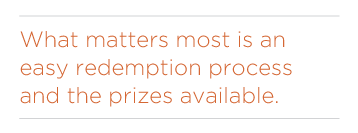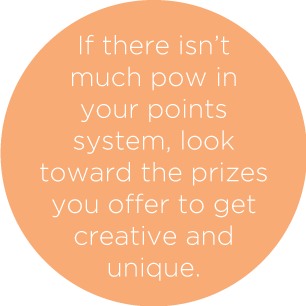As long as loyalty marketing and reward programs have been around, there’s more than enough data to cull together to see which work the best and which don’t. Some big companies have notably completely changed their programs in an effort to meet customer satisfaction demands while reducing costs and fraud potential.
So which are some of the most effective types of rewards and loyalty programs that bring customers coming back again and again? While there are admittedly a host of factors that play into this behavior, if you can remember the Four Ps, you’ll be in good shape.
1. Points
It may sound pretty boring and vanilla, but the tried-and-true point accumulation system is ubiquitous for a reason – it works. Consumers have been accustomed to earning reward points for their purchasing behavior for decades now, and concept familiarity should not be overlooked when instituting your own loyalty program. Not only will new subscribers be instantly comfortable with your program, but a points system allows for a staggering amount of variety.
Some points programs are straightforward, such as Best Buy’s Reward Zone program which earns 1 point for every $1 spent, while some are a bit more byzantine and assign higher point values for each dollar spent or visit to the store.
 There have been studies that show higher point values may be directly correlated to increased customer spending (earning 10 points instead of 1 for each dollar, but making the rewards cost 10 times as many points to redeem), but what matters most is an easy redemption process and the prizes available.
There have been studies that show higher point values may be directly correlated to increased customer spending (earning 10 points instead of 1 for each dollar, but making the rewards cost 10 times as many points to redeem), but what matters most is an easy redemption process and the prizes available.
Another aspect to consider adding to your points system is artificial advancement. For example, say your pizza restaurant wants to start offering free pies to loyal customers – after crunching the numbers, you find that after four small pizzas purchased at the full price, it makes fiscal sense to give away a fifth one for free. Each pizza equals one point, and a free pie is earned for every four points. You could start new members of your reward program off with a points card with a zero balance on it… OR, you could offer them a card that requires five points for a free pizza, but you’re going to be awesomely generous and put their first point on there for free, on the house. In each example, the customer will have to buy four small pizzas in order to earn a free one, but numerous studies have proven that customers in the second group are much more likely to actually earn that free pie.
It’s a psychological aspect of feeling closer toward completion – they are already 20% of the way to their goal when they start, versus 0% when starting out at 0/4. Plus, when the second group earns their first free pizza, they’ll have to buy five again, not four, to earn a second free pie, meaning more revenue for your business.
Download our free customer loyalty success guide to learn how to drive customers back 2x more.
2. Prize Variety
If there isn’t much zip or pow in your points system, look toward the prizes you offer as the most sensible and likeliest place to get creative and unique. After all, this is what gets your customers excited and likely why they enrolled in your loyalty program in the first place – here’s where you validate that excitement and build more of it.
A highly effective method that many larger loyalty programs utilize is offering up a good mixture of smaller, entry level rewards that are earned early and often, and larger, top tier prizes that are hard to earn but are well worth the wait and effort.
This gives options to the customer – they can redeem their points at a high frequency for smaller items, or save them up and cash them in for the big, extravagant prizes. One of the better examples of this is credit card reward points. Although there are small variations between the major card companies, the basic premise remains the same – each dollar spent equates to a point amount, and those points are redeemed for prizes.
There are many ways in which to earn double, triple, sometimes even quintuple points on selected purchases, but it is ultimately up to the consumer to spend those earned points. Some opt for smaller rewards, such as $10 gas cards, $15 iTunes cards or $20 gift cards to various retailers. Others opt to hold onto their points for years – depending on their spending habits, this might earn them week-long all-inclusive trips to locations around the globe or even bigger, more valuable prizes.
3. Partnerships
Variety is important (it IS the spice of life, after all…), but with so many competing loyalty programs out there for each industry, giving your customers a good value for their spending is paramount.
 Nobody’s going to be too eager to sign up for a loyalty program that requires you to spend thousands of dollars for gimmicky trinkets or tchotchkes in return. By the same token, no business will be in business for long if the rewards they give out aren’t financially feasible. You don’t want rewards to put you out of business.
Nobody’s going to be too eager to sign up for a loyalty program that requires you to spend thousands of dollars for gimmicky trinkets or tchotchkes in return. By the same token, no business will be in business for long if the rewards they give out aren’t financially feasible. You don’t want rewards to put you out of business.
A great way to mitigate this is to partner with other businesses for the rewards you offer in your program. By partnering with another business, you can offer a higher value reward for less money – the company you negotiate with will offer you their goods and/or services at a highly discounted rate in exchange for the PR value and visibility you will be giving them by offering their wares.
You can even up the ante a bit and hold special promotions where purchases made during a specific time frame will get customers double or triple points ONLY toward the partner’s items. People will be drawn in by the value, and the partner will undoubtedly appreciate the free advertising.
4. Philosophy
While point accumulation and value are definitely the most effective means of roping in new loyal followers, don’t overlook the importance of philosophical or emotional attachment when choosing which rewards you’ll be offering. This doesn’t apply to each and every business, but if your company has a clearly defined mission or cause, odds are that your loyal customers will have it too.
For example, TOMS shoes is well-known for its mission of donating one pair of shoes to people in impoverished or developing countries for each pair of shoes sold. They have been wildly successful, in large part due to this remarkably charitable business model. And as you might guess, people who buy TOMS can be pretty passionate about giving back as well. What do you think would make more sense for TOMS to offer as a reward for loyal customers, based on their corporate vision – further charitable donations to other like-minded causes, or allowing its members to earn flat screen HDTVs after lots of purchases?
Your philosophy as a business can and should dictate the types of rewards you give out and which companies you partner with. Select things that are closely related to your business and products so you know that people who regularly frequent your business will be interested in the goodies you offer.
If you run a dry cleaning business, for example, you could offer discounts to local clothing outlets to your repeat customers. Or let’s say you operate a maid or housecleaning service – odds are decent that your clients are fairly busy people who don’t have the time to do a lot of the maintenance of their home or yard. They’d most likely be interested and appreciate a voucher for discounts on similar services, such as child care, tree pruning or yard work, dog walking, etc.
By selecting rewards (even non-monetary ones) that are similar to what you offer, you reduce the likelihood of customers becoming disengaged in your loyalty program due to a lack of compelling rewards.
Keep your eyes on the prize with some practice
While these Four Ps are a great way to increase your loyalty program’s success rate, a possible fifth P would be Practice. Try out different systems and rewards to see what fits your model best. Don’t be afraid to switch up your partners if you feel you can get a better deal on prizes that are more beneficial and applicable to you most loyal customers. And above all else, listen to your members – their feedback will prove invaluable in your efforts to tailor your program into a winner.







I am wanting to know how many points I have
Hi Mary! To view your points, you’ll want to sign in (or create an account) online at https://fivestars.com, or log into the mobile app. There, you’ll be able to view all of the points to have at each FiveStars business you’ve visited.
Thank you!